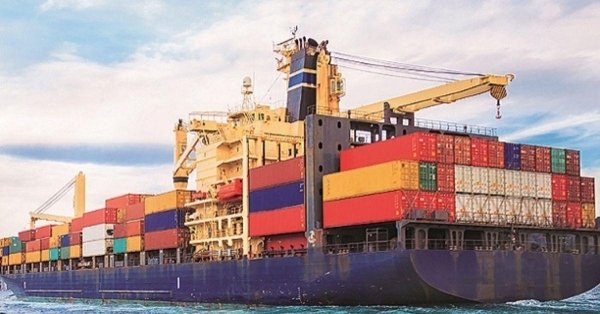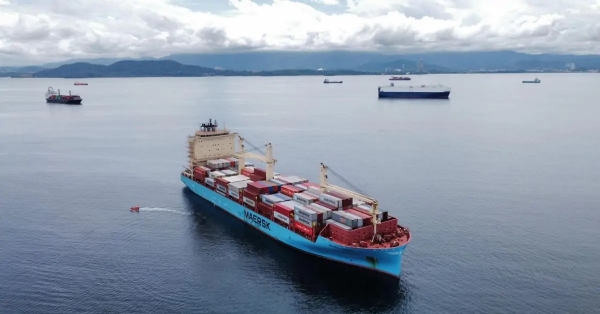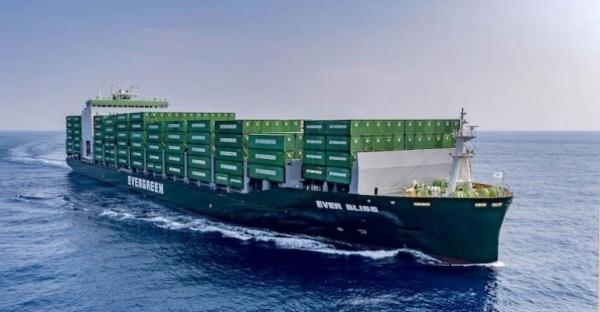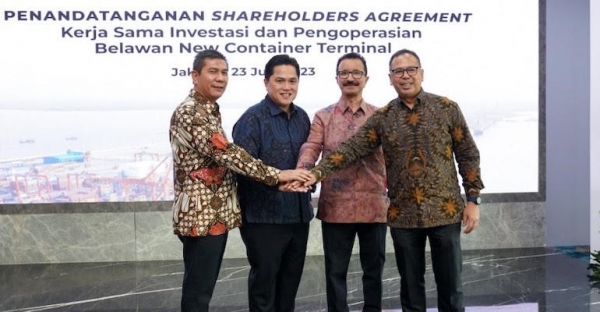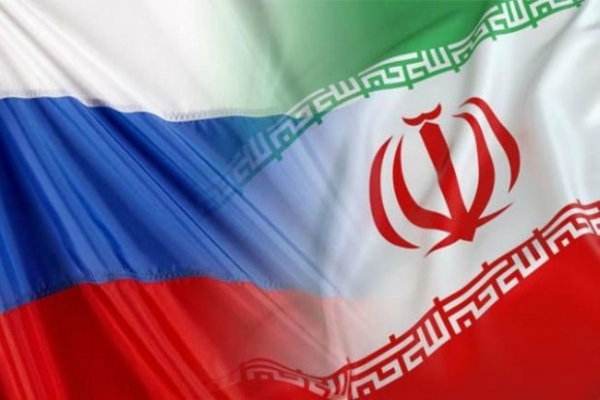News
Latest news
Iran-Russia Mulls Forming Shipping Firm That Could Complement INSTC
Iran and Russia are mulling to form a shipping firm that could complement INSTC that connects India with Russia via Iran.
Iran’s Ambassador to Russia Kazem Jalali recently stated that authorities in Tehran and Moscow are exploring the formation of a cooperative shipping firm as part of efforts to strengthen strategic cooperation.
Jalali stated this in an interview with the Rossiya-24 TV channel on Friday as he pointed to efforts to strengthen Tehran-Moscow’s maritime fleet.
“There is a need to reinforce our ports; there is a need to strengthen the shipping fleet. Even to create a joint shipping company. I just had a conversation with First Deputy Prime Minister of Russia Andrey Belousov. Iran’s Minister of Transport also discussed this topic with him. Our Russian counterparts welcomed the creation of a joint shipping company,” the Iranian diplomat stressed.
He stated that “countries need to develop ports and link them like railroads. The potential for freight shipping is huge there.”
Moscow and Tehran are collaborating on a number of fronts to promote bilateral commerce, hasten development of transport links including the International North-South Transit Corridor and its Caspian Sea component, and integrate their banking systems to make it easier to conduct financial operations. Recently, Iran-India-Russia held a high level meeting on smooth implementation of INSTC.
The move comes as Iran and Russia prepare to conclude a long-term strategic cooperation deal, which will open up several new areas for collaboration.
Trade exchanges between the two nations quadrupled in 2022. Russia became Iran’s biggest foreign investor during the Iranian calendar year that ended in March with investments totaling $2.76 billion.
Iran and India are also focusing on full optimization of the Chabahar Port that would also boost connectivity to Central Asia.
Maersk Begins Construction On New Distribution Centre In Singapore
A.P. Moller-Maersk (Maersk) is launching a new 1.1 million square-feet distribution Centre in Jurong West to strengthen its Omni-channel-fulfilment capabilities in Singapore.
The World Gateway 2 inaugural ceremony was held on 19 July 2023, and it is expected to be completed in Q1 of 2025.
Strategically located in the industrial area with direct access to major highway, Ayer Rajah Expressway (AYE), the facility has convenient access to Tuas Mega Port and Changi International Airport.
It is also within close proximity to World Gateway 1, currently Singapore’s largest automated and customs bonded warehouse.
The new distribution Centre is designed to have a capacity of 30,000 pallet Automated Storage & Retrieval System (AS/RS), with a large floorplate of 160,000 square-feet.
This multi-story facility will have a high ceiling with 11-metre clear height per floor, suitable for dense storage and automation.
Equipped with ample loading bays and container parking places to manage peak season volumes, Maersk explained in a statement that the Centre will cater to the booming e-commerce fulfilment needs, as well as offering logistics solutions for different industries.
“Maersk’s World Gateway 2 regional distribution Centre will increase Singapore’s capacity and capabilities to support Omni channel fulfilment in Southeast Asia,” said Chairman of Singapore Economic Development Board, Png Cheong Boon.
“With extensive use of automation and robotics systems, it will be one of the most productive warehouses in Singapore and will also create many skilled and high value jobs in technology, digitalization, data analytics and e-commerce.”
This new facility will be both LEED Platinum – and Green Mark Platinum – certified for its outstanding design and performance in environmental aspects, Maersk reported.
It will be equipped with motion sensor-LED lights, solar panels, composite panel façade system for building insulation, and building management system for energy efficiency.
Dominic Gates, CEO of Omni channel-fulfilment, Maersk Asia Pacific, further stated: “Our powerful Omni channel-fulfilment solutions enable our customers to have predictability, visibility, and efficiency in their supply chain, improving their profitability and brand reputation in today’s complicated marketplace.
“Expanding the warehousing footprint and Omni channel-fulfilment competence is essential to our strategic growth, and we’re very excited about the opportunities that lie ahead.”
This announcement comes just over a week after Maersk announced the delivery of the world’s first containership powered by green methanol.
In the same week, Maersk announced its plans to implement an artificial intelligence (AI)-enabled robotic solution in its latest UK warehouse in East Midlands.
AP Moller Maersk has taken delivery of the world’s first containership operating on green methanol
The 2,100-teu HMD Hull 4168, was built at Hyundai Mipo Dockyard Co. and Hyundai Heavy Industries Co. The vessel is set to embark on its maiden voyage towards Copenhagen where, in a ceremony, Ursula von der Leyen, the President of the European Commission will christen Maersk’s new feeder vessel.
“The introduction of this container vessel is a significant step towards realizing our commitment to becoming carbon neutral, and it marks the beginning of a new era in shipping, where we together can minimize greenhouse gas emissions and create a greener future,” Maersk said.
Maersk said the 21,500 km trip from Ulsan, South Korea to Copenhagen, Denmark, will provide real operational experience for Maersk seafarers handling the new engines and using methanol as fuel. The feeder will be followed by 18 large oceangoing vessels of 16,000-17,200 TEU capacity which are scheduled for delivery in 2024 and 2025.
Maersk has secured green methanol for the ship’s first trip in cooperation with the Dutch producer and distributor of hydrogen-based products OCI Global. The company OCI will provide ISCC-certified green bio-methanol to power the maiden voyage of the new build.
As part of its decarburization strategy, Maersk has also recently ordered six mid-sized container vessels at Yangzijiang Shipbuilding Group. The six 9,000 TEU vessels will all have dual-fuel engines able to operate on green methanol and fuel oil. The ships are projected for delivery in 2026 and 2027.
Taiwan-based shipping line Evergreen is planning a massive fleet expansion plan and ordering twenty-four 16,000 TEU methanol dual-fueled containerships at a total cost of up to $5 billion.
The order will be split in eight and 16 units between Japan’s Nihon Shipyard and South Korea’s Samsung Heavy Industries, respectively.
Vessel delivery dates are uncertain at the moment as the official contracts with shipyards had not been signed yet, according to Evergreen.
To date, Evergreen operates 214 vessels with a combined capacity of 1.676m TEU. The company is expecting to have two new vessels to be delivered this year and twenty-two to be delivered in 2024.
Methanol is increasingly the alternative fuel of choice for containership newbuilding.
DP World takes over operations at Bela wan New Container Terminal
The strategic partnership between the Indonesia Investment Authority (INA), Indonesian government-owned port operator Pelindo, and DP World, will create Indonesia’s most direct link with the Malacca Strait, one of the world’s busiest shipping routes.
Sultan Ahmed Bin Sulayem, Group Chairman and CEO of DP World, Arif Suhartono, President Director of PT Pelabuhan Indonesia (Persero), and Ridha Wirakusumah, CEO of Indonesia Investment Authority, signed the agreement.
The agreement aims to increase BNCT’s capacity to 1.4m TEU, up from 600,000 TEU currently. BNCT will also aim to attract more direct calls, reducing North Sumatra’s reliance on regional hub ports to access regional and global markets.
The Malacca Strait region is served by three major transshipment hubs – Singapore, the Port of Tanjung Pelepas, and Port Klang, which feeder cargo to smaller ports across Southeast Asia such as Belawan in Indonesia.
The BNCT currently serves as a local hub for the neighboring provinces in Sumatra and the expansion and modernization programmed aims strengthen its position as a major trade and logistics gateway in the Malacca Strait.
Indonesia’s Minister of State-Owned Enterprises, Erick Thohir, stated that "As directed by President Joko Widodo, there is always strategic value for equity and acceleration of economic growth in the regions and nationally through port development, including this new container terminal at the Port of Belawan which is believed to support downstream to maximize exports in new ways and also accelerate the economy in North Sumatra which continues to grow. This is in accordance with the objectives of the Terminal port development which will strengthen the national port industry ecosystem, as well as the competitiveness of Indonesian ports as strategic trade routes in Southeast Asia and internationally."
"We are proud to help Indonesia expand the Belawan New Container Terminal and support its ambitions to develop the economy of Sumatra through infrastructure. By investing in cutting-edge sustainable technologies, world-class training and the highest standards of health and safety, we aim to eliminate inefficiency and enable the flow of trade between Indonesia and the world," said Sultan Ahmed Bin Sulayem, Group Chairman and CEO of DP World.
India And Russia Keen To Start Chennai-Vladivostok Maritime Route
India and Russia are keen to make the Chennai -Vladivostok maritime route operational, and a stakeholder meeting to work out details have been scheduled in September, Union Minister for Ports, Shipping and Waterways Sarbananda Sonowal said.
The Vladivostok – Chennai route passes through the Sea of Japan, the South China Sea and Malacca Strait.
The proposed route is expected to take only 12 days, compared to the current route’s duration of 32 days. The new route would provide India with access to the Far East and open up opportunities for trade between the two countries.
The new route would provide India with access to the Far East and open up opportunities for trade between the two countries.
Iranian oil Is quietly flooding into the Global market again
Iran is shipping the most crude in almost five years, fortifying its re-emergence on the geopolitical stage while posing risks for a fragile global crude market.
Exports have surged to the highest level since US sanctions were re-imposed in 2018, according to a range of analysts including Kpler Ltd., SVB Energy International, FGE and the International Energy Agency. The vast majority is flowing to China, as the world’s biggest importer scoops up cut-price barrels from the Islamic Republic.
Rebounding sales are the most tangible sign yet that the country — while still reeling financially from years of isolation — is reasserting itself, having started to repair ties with regional rivals, fostered relations with Asia’s leading power, and even begun a tentative diplomatic engagement with Washington.
Yet the extra supplies are sapping confidence in an oil market weakened by faltering economic growth and cheap Russian cargoes, frustrating efforts by Iran’s partners in the OPEC+ alliance to put a floor under crude prices.
“Iran’s crude exports smashed it last month,” said Homayoun Falakshahi, a senior analyst at Kpler. “Iranian crude is extremely interesting for those willing to take the risk to buy.”
Crude shipments have doubled since last autumn to reach 1.6 million barrels a day in May, even as American sanctions remain in place, according to the firm. Production has hit 2.9 million barrels a day, the highest since late 2018, the Paris-based IEA estimates. Consultants SVB Energy, Petro-Logistics SA and FGE believe that output is even higher, maybe surpassing 3 million barrels a day.
The recovery in flows — severely curtailed after former President Donald Trump quit a nuclear accord with Tehran in 2018 — could bolster an economy battered by rampant inflation, a plunging currency, and periodic unrest against hardline President Ebrahim Raisi.
It coincides with other signs of Iran’s revival: a preliminary accord with regional adversary Saudi Arabia in April, efforts to rehabilitate Syrian ally Bashar al-Assad, and clandestine talks to lower tensions with the White House.
Through negotiations between intermediaries in Oman and on the sidelines of United Nations meetings, Washington and Tehran are inching toward an understanding to free American prisoners and explore limits on Iranian nuclear research, in exchange — according to a person familiar with the Iranian position — for leeway to ship more crude.
A State Department official said rumors of a nuclear deal are “false and misleading” and the US priority remains to stop Iran from obtaining a nuclear weapon. Iran says its atomic program is for peaceful purposes only.
Yet additional shipments — adding to flows from two other OPEC+ members under sanctions, Russia and Venezuela — are already happening, hitting global oil markets. Prices have retreated 12% this year to near $75 a barrel in London, spurring a flurry of downgrades by forecasters like Goldman Sachs Group Inc. and JPMorgan Chase & Co.
Iran’s surge has undermined efforts to stabilize the market by the Organization of Petroleum Exporting Countries and its leader, Saudi Arabia, which this month announced a new production cutback of 1 million barrels a day, to little effect.
Ever since US sanctions were reimposed five years ago, Iranian crude has been shipped to its few remaining buyers on a so-called “dark fleet” of tankers — often aging and uninsured — that de-activate transponders to avoid detection.
While tanker-tracking shows that China has remained Tehran’s main customer, official data registers no imports from the Islamic Republic in the past year. Instead, purchases have soared from Malaysia, where Iranian cargoes are often sent for transfer to another ship, blurring the consignment’s origins.
“These ghost barrels are not counted in the official total,” said SVB founder and president, Sara Vakhshouri. But “while the whole of OPEC+ is trying to cut as much as possible, and Saudi goes with a voluntary cut, every barrel counts.”
Chinese refiners — especially smaller, independent companies in Shandong province — are ramping up purchases of Iranian cargoes as the price discounts offered by Tehran help offset a recent slump in profit margins, Kpler says.
Iran has had to deepen discounts to its crude to compete with an influx of Russian crude pushed out of Europe by sanctions, according to Iman Nasseri, managing director at FGE in Dubai. The increased flow is drawing heavily from crude it had stockpiled on tankers to satisfy the demand, the companies say.
“China’s willingness to support Iran by taking its sanctioned oil, suggests a slight improvement in Iran-China relations,” said Greg Brew, an analyst at consultants Eurasia Group. “All of this supports the view that Iran’s position is improving, along with its advancing normalization with other regional states.”
It was Beijing that brokered the fledgling detente between Iran the Saudis — a symbol of the growing closeness both countries seek with Asia’s rising power — as the Middle East rivals seeking to defuse decades of proxy conflicts, such as the ongoing war in Yemen.
Besides the increased appetite from China, some analysts have speculated that the surge has been tacitly permitted by a US government intent on keeping gasoline prices in check. Turning a blind eye could also help as the two countries work on a building a diplomatic channel.
“There’s been less enforcement of the sanctions by a US administration wanting to counter Russian crude in the market while also keeping supply flowing,” said FGE’s Nasseri.
The impact on oil prices from Tehran’s comeback could be limited going forward. Crude deliveries to China may slow while authorities conduct a crack-down on bitumen mixture, which traders suspect is used as a cover for denser and cheaper barrels sold by Iran.
In any case, global oil markets are set to swing into a sharp deficit for the rest of the year as China’s post-pandemic rebound gathers pace, the IEA predicts. Demand will exceed supply by roughly 2 million barrels a day in the second half of the year, more than enough to absorb additional Iranian flows.
Crude traders remain skeptical of the projected supply tightness, in part as the swelling tide of barrels from Iran casts a shadow on the outlook.
“Negative supply side anxiety is palpably shaping the mood,” said Tamas Varga, an analyst at broker PVM Oil Associates Ltd. in London, adding that extra Iranian flows are part of that.
–With assistance from Sharon Cho, Serene Cheong, Alex Longley, Paul Wallace and Jonathan
Iranian minister calls for joint shipping firm with Russia
On a trip to Russia, the Iranian road minister Bazrpash has called for a formation of joint shipping company between the two countries to facilitate trade and transit.
The Iranian Minister of Roads and Urban Development, Mehrdad Bazrpash, who arrived in Russia to participate in 26th St. Petersburg International Economic Forum (SPIEF), met and discussed with the Chairman of the State Duma Transport Committee, Yevgeny Moskvichyov.
During the meeting, a quadrilateral agreement was reached between Iran, Russia, Uzbekistan and Turkmenistan regarding the transit route, standard fuel, road and sea.
The two sides also agreed on the maritime domain and Amirabad, Anzali and Caspian ports.
The Iranian minister also met and held talks with the Russian President’s Special Aide, Igor Levitin, during which the sides discussed the transportation facilities from Volga and Caspian Sea.
Irek Faizullin, Minister of Construction, Housing and Utilities of the Russian Federation told the Iranian road minister in a meeting on the sidelines of the conference that his country is interested in the imports of Iranian-made construction materials as they are produced at a high quality.
Also, a joint meeting with the governors of Astrakhan, Chelyabinsk and Samara was one of the other plans of the representative of the Islamic Republic of Iran on that trip.
In that meeting, the Iranian road minister emphasized the importance of implementing the existing potential in relation to Russia and the establishment of a joint shipping company as soon as possible.
The 26th St. Petersburg International Economic Forum (SPIEF) is one of the biggest and most important business events in the world. SPIEF has been held annually since 1997. Since 2005, it has been held under the auspices of the President of the Russian Federation, who has also attended each event.




















